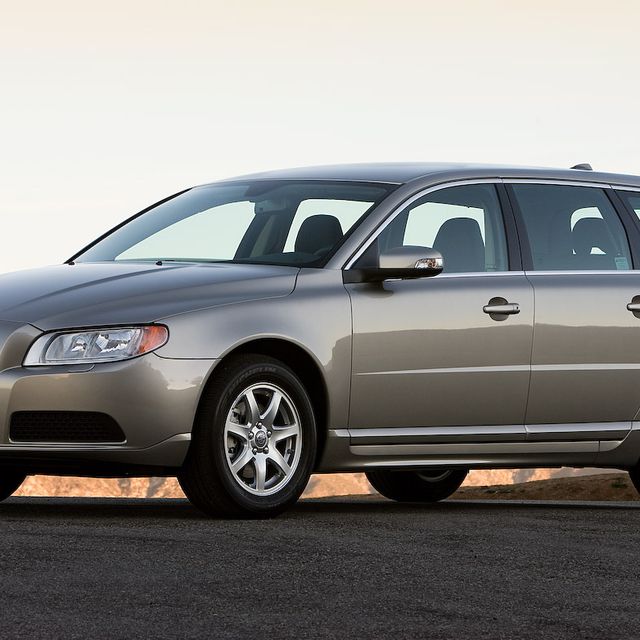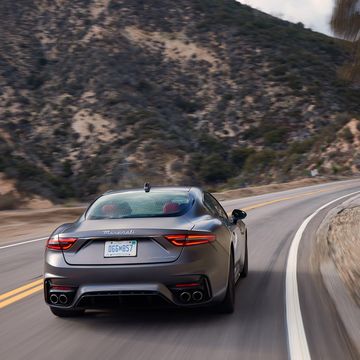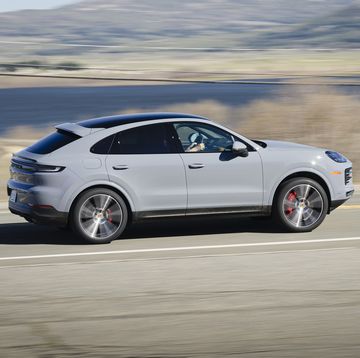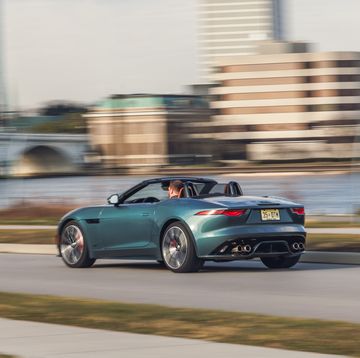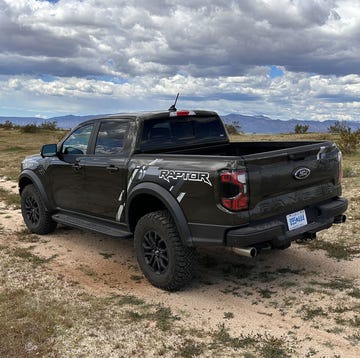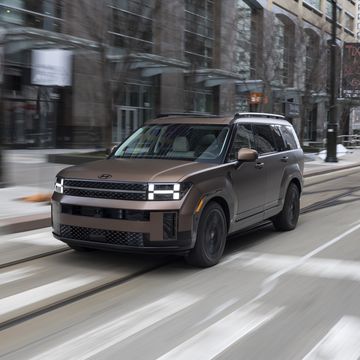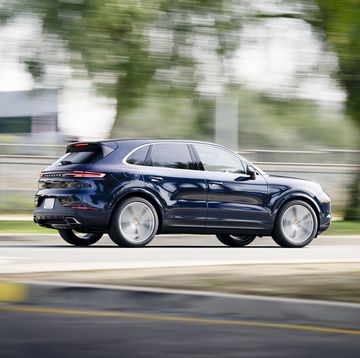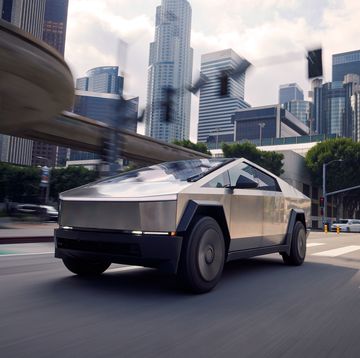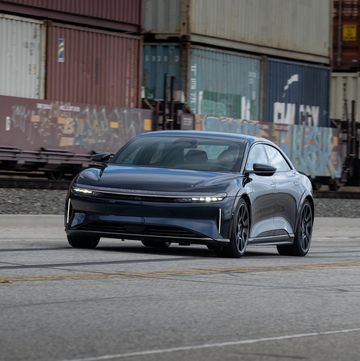In our last road test of a Volvo sedan [May 2007], we likened a top-of-the-line S80 AWD’s appeal to eating particle board. Given that the V70 wagon is based on the S80, the outlook for Volvo’s new wagon is not good.
But hold on a minute. One reason for our lack of enthusiasm for the loaded S80 AWD V-8 was its $56,025 as-tested price tag, putting it in a segment with exemplary models from BMW, Audi, and Mercedes. The V70, available only in front drive with a 3.2-liter inline six-cylinder engine, rings up at a base price of $33,210. At that number, the V70 is an entirely different proposition. It’s even $6240 cheaper than the six-cylinder S80 and $4310 less that its all-wheel-drive sibling, the XC70. And despite the price break, the V70 rides on the same platform as the S80. That means the same crash structure and the same safety equipment: front, side, and curtain airbags; anti-whiplash headrests; and panic brake assist.
Things are looking better for the V70 than its sedan sibling. On a literal level, the V70’s looks are underwhelmingly pleasant. The old V70 went out of its way to define a new look for Volvo. The new wagon is a step backward from that boldness. Its character has been ironed out in the form of smoother, rounded sheetmetal. The new design retains the rear taillights that run from the bumper to the roof, now a Volvo wagon trademark. The V70 looks thoroughly modern, even classy, but it’s not going to shatter any preconceptions about the stylishness of wagons.
The previous V70 was based on the smaller S60 sedan, so it’s not surprising that the new car is longer (up 4.5 inches to 189.9), wider (73.3 inches, an increase of 2.3), and taller (by two inches, to 60.6) than before. The wheelbase has stretched 2.3 inches to 110.8. Compared with the V70 T5 we tested in July 2000, the ’08 V70 is 156 pounds heavier.
The V70’s only available engine is the 3.2-liter inline six-cylinder making 235 horsepower and 236 pound-feet of torque. It’s a big gain from the 157 horsepower that the old base engine produced and only 12 horsepower shy of the go-fast T5’s 247.
The inline-six has its appeal, even if it lacks the oomph of the old T5. It’s the same engine found in other Volvos, as well as in the Land Rover LR2, and it features variable intake-valve timing. It’s mated to a six-speed automatic. Smooth is the name of the game, and unlike in the old turbo, torque steer is nearly imperceptible.
The 0-to-60-mph sprint happens in a respectable 7.5 seconds. That’s only 0.3 second behind the T5 and more than a second quicker than the V70 Cross Country with the base engine that we tested in October 2000.
Respectable, yes, but perhaps not noteworthy. This seems to be a recurring theme. The V70, however, only comes across as a wallflower because it takes a while for its charm to sneak up on you. Generally, we’re not fans of a spongy brake pedal and muffled steering feel, but both reflect the V70’s serene nature. Of course, we would applaud a stopping distance shorter than 178 feet, grip greater than 0.83 g, or handling that would make us wish even more for a stability-control system that turned off completely. Sure, it doesn’t corner like a BMW, but it doesn’t seem like that’s what the V70 is going for, unlike the S80. If you’re looking for more sport in your wagon, you might find it in the Saab 9-5 SportCombi, Subaru Outback 2.5XT, or Volkswagen Passat 3.6 4MOTION. But only the Subaru is close on price—the VW and the Saab are nearly 40 grand—and none of those cars feels as solid and composed as the V70 going down the road. The quiet comfort that the V70 provides is the automotive equivalent of Grandma’s meatloaf. It makes you feel better after a long day.
We certainly wouldn’t mind a long commute in the V70’s front seats. Like most of the interior, the front buckets are shared with the S80 and provide unobtrusive comfort—the kind you don’t always notice because there’s nothing making you uncomfortable. The floating center console, with its large radio dials and iconic climate-control buttons, is a welcome carry-over as well. Volvo should take a cue from Scandinavian design, though, and stick with light colors. The black interior in our test car inspires seasonal affective disorder; the alternate choice of beige trim is certainly more cheerful.
Fittingly for a wagon, the V70 shows some character behind the front seats. The rear bench splits 40/20/40, so you can haul long items and still seat two in the back comfortably. The outboard seats have integrated booster seats for kids. Pop the cushion backward and up for children weighing 48 to 79 pounds. A second position fits munchkins between 33 and 55 pounds and is higher to allow even shorter kids to look out the windows. Power locks and windows for the rear can be deactivated from the driver’s seat by one push of a button.
Further astern is a thin, partitioned space under the cargo load floor. There are also two parallel rails that, combined with slots below the side windows, accommodate as many hooks, dividers, and cargo nets as your wallet can afford. Without these doodads, the V70 affords 33 cubic feet of cargo space, expanding to 72 cubes with the rear seats folded.
If you want to get to the cargo area the lazy way, a power-operated liftgate is included in the $2220 Convenience package. Further options include a sunroof and leather luxury package, 17-inch wheels, a pop-up navigation system, a DVD entertainment system, and bixenon headlamps. For the safety conscious and cash oblivious, the blind-spot-indicator system, lane-departure warning, and adaptive cruise control with collision avoidance are all options, but we’re cheap enough to learn how to properly adjust our mirrors and keep our eyes on the road.
Our advice is to go light on the options and focus on the main course instead of the garnishes. Push the sticker price too high, and the V70 will enter a more competitive stratosphere such as the one in which the S80 languishes. Besides, every option on the order sheet won’t change the smooth and transparent way the V70 covers highway miles.
The V70 doesn’t have a sporting nature, but it doesn’t have sporting pretensions, either. It drives better than most SUVs and has more cargo space. Our observed fuel economy, at 21 mpg, was a little too close to some off-roaders’. Still, for driving enjoyment, we’ll take a car over a truck any day, and the V70 is no exception. It’s a mighty comfortable wagon, and that’s just fine with us.
LARRY WEBSTER
When I was growing up, domestic station wagons were the float machines, and Euro wagons were the cooler, sportier models that only the rich kids got to ride in. Times change. This Volvo’s cushy ride and slow responses felt close to my mom’s 1982 Chevy Caprice, but thankfully, the V70 doesn’t bob in a way that invokes nausea. I kept thinking that if GM still built a station wagon, it would feel like this Volvo, except it wouldn’t have the Volvo’s quality interior or comfortable seats.
CSABA CSERE
My wife has been driving a previous-gen V70 for six years, so I was eager to see the progress on the new model. Although I prefer the long flowing lines on my wife’s car to the more generic curves of the new one, the ’08 is richer and more attractive inside. Swapping the old mildly blown inline-five for the new inline-six isn’t a big change, but the chassis upgrades address the biggest failure of the old car—its flinty, noisy ride. Altogether, this is a good wagon made better.
